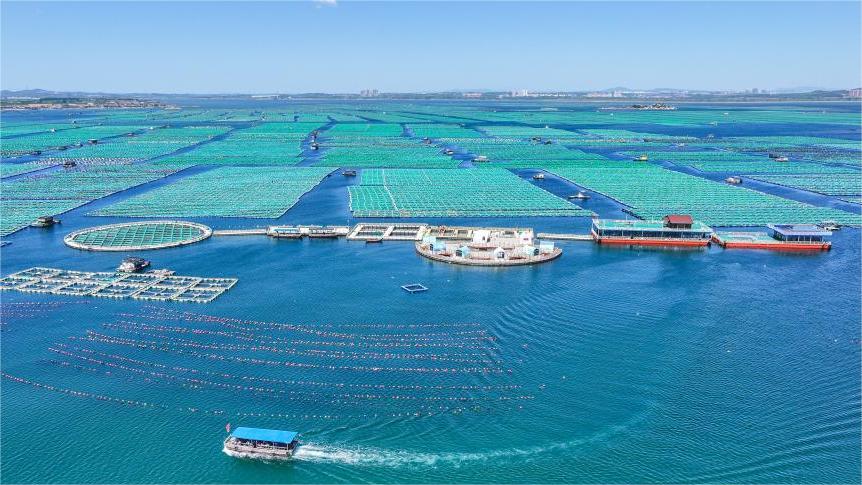Recycled products shatter old ideas about ceramic waste
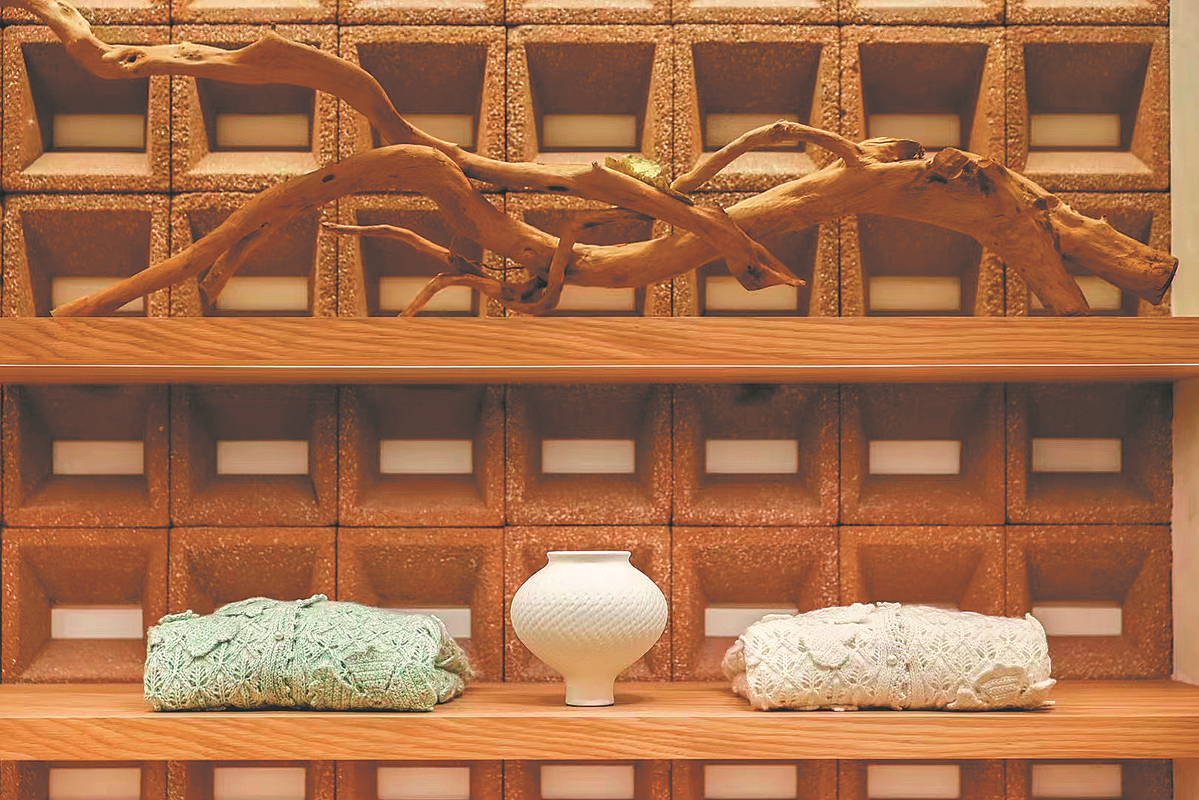
Hollow bricks made of waste ceramics are used as a backdrop for products at a wool sweater store in Shanghai. CHINA DAILY
Every two months, Yan Chunyang hauls the accumulated ceramic waste from his studio to two large green bins, which serve as designated recycling points for ceramics.
"It has been about two years since I started taking ceramic waste to the recycling point. Many other studio owners in Jingdezhen also go there to dispose of their waste ceramics," he said.
Yan is a 33-year-old freelance artist who set up his ceramic 3D-printing studio in Jiangxi province's Jingdezhen, the country's porcelain capital, in October 2021.
He quickly became a vendor at the Letian Pottery Creative Market, showcasing and selling his products every Saturday along with other vendors.
"When I started making ceramics in Jingdezhen, I couldn't bear to throw away flawed pieces," Yan said. "But as I produced more, I began to have higher standards for product quality, and that's when the need to deal with waste ceramics arose."
Soon after, Yan discovered a ceramic waste recycling point at the market.
After each ceramic-making session, he collects waste materials and fills up a large box. Once the box is full, he takes it to the recycling point. Many other vendors at the market follow the same practice and take their ceramic waste to the recycling point.
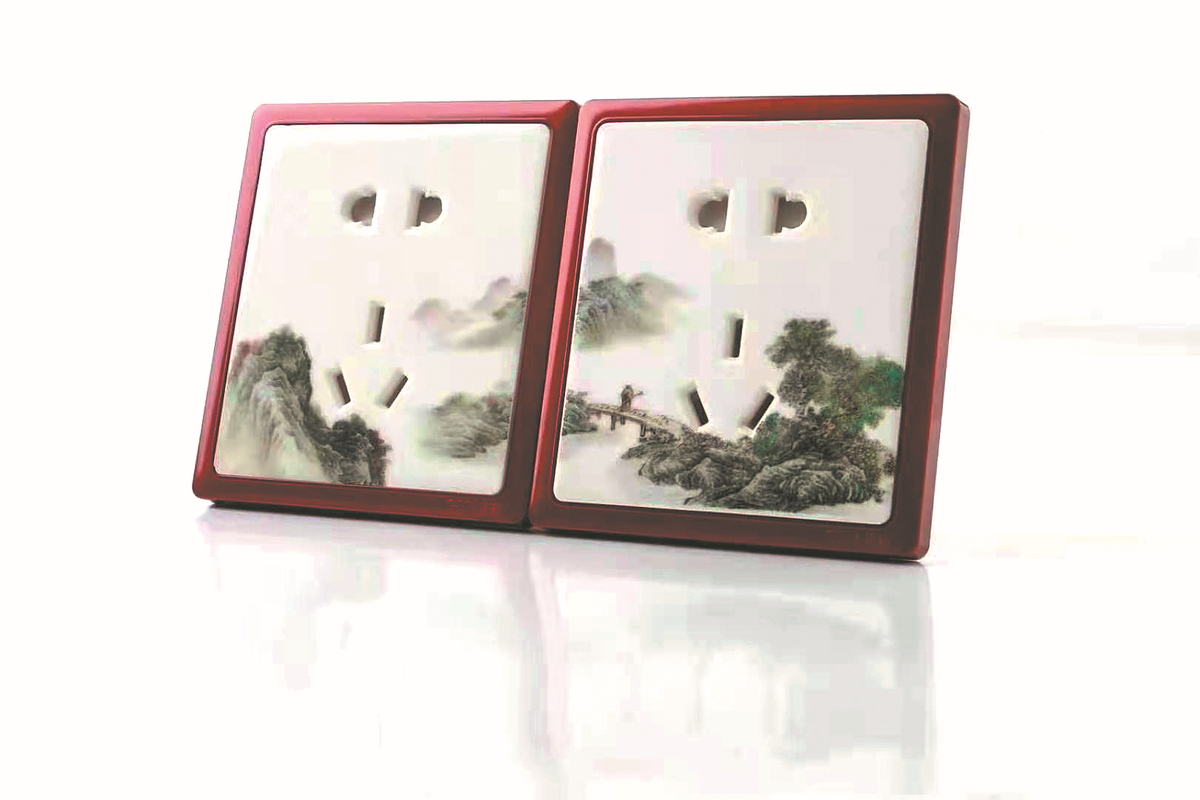
Sockets made of waste ceramics produced in Jingdezhen. CHINA DAILY
Waste into wealth
China has been the world's main producer of traditional ceramics for many years.
In 2017, China produced approximately 10 billion square meters of architectural ceramics, 220 million pieces of sanitary ceramics, and 50 billion pieces of daily-use ceramics, according to research by Wang Yongqing, a professor at Jingdezhen Ceramic School of Materials Science and Engineering.
The Central China region accounted for 25 percent, 55 percent, and 45 percent of these outputs respectively, while Jiangxi was the third-ranked province in traditional ceramic production.
However, the thriving ceramic industry has created a problem: How to deal with the large amount of non-degradable ceramic waste produced by manufacturing companies?
Jingdezhen alone produces more than 60,000 metric tons of ceramic waste annually, with an estimated 18 million tons produced nationwide.
"There are many types of ceramic waste, not just traditional daily-use ceramics, but also architectural ceramics, sanitary ceramics and more," said Wang. "Currently, some ceramic waste is recycled, but many companies still resort to traditional landfilling."
Ceramic production has always been a hit-and-miss process. In the past, wood-fired kilns had a success rate of only 30 percent in ceramic production, and failures were common.
As a result, a significant amount of ceramic waste was dumped as landfill into low-lying areas of Jingdezhen to prevent flooding and waterlogging. This led to the development of densely populated areas with extensive construction after hills and streams were leveled and covered.
Ceramic waste and kiln bricks were also used to construct Jingdezhen's sewers. Even today, walls from the Qing Dynasty (1644-1911) and pools from the Ming Dynasty (1368-1644), built with discarded ceramics, kiln bricks, and other fragments, can be seen among the ruins of the Imperial Porcelain Factory in Jingdezhen.
However, as industrial ceramics production has grown, it has become necessary to handle ceramic waste in a more environmentally friendly manner.
"In the past, Jingdezhen recycled only a small amount of ceramic waste, while the rest was buried. But because the amount of ceramic waste was small, the environmental impact was far less than it is today," Wang said.
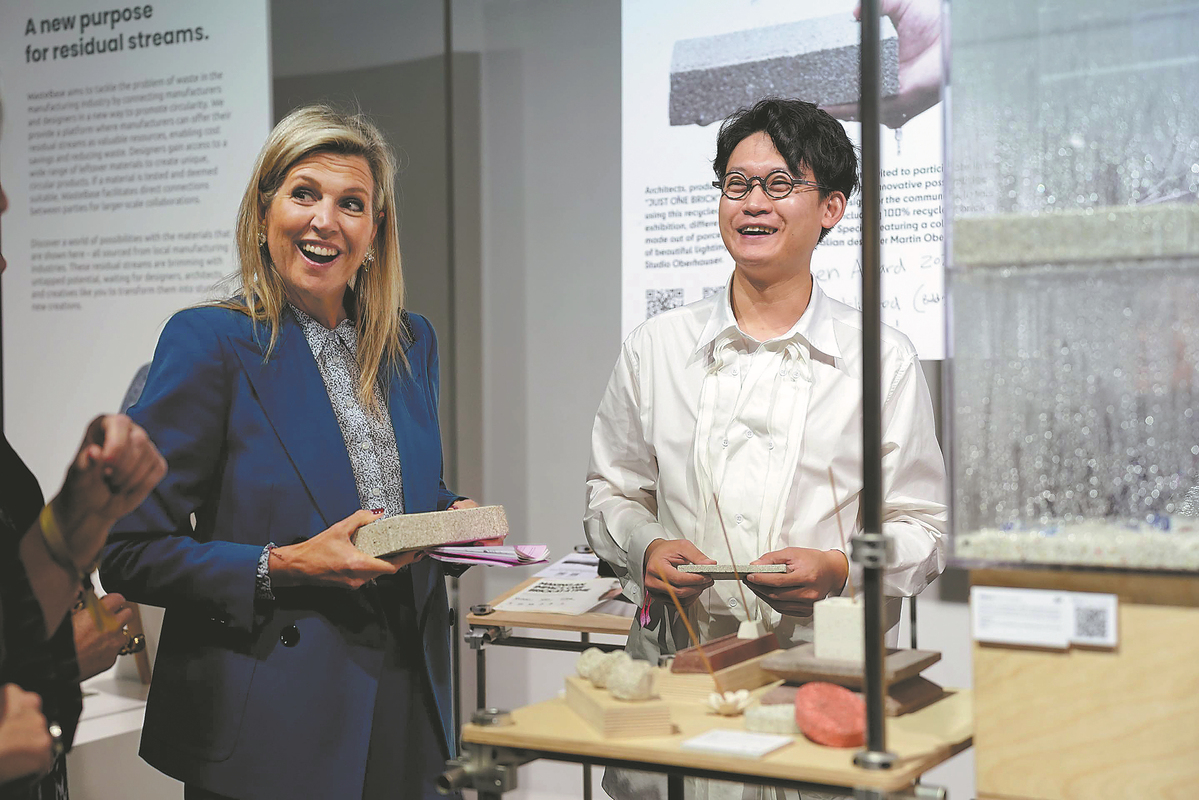
Queen Maxima of the Netherlands holds a brick made of recycled ceramics by Yi Design during Dutch Design Week in October. CHINA DAILY
"Ceramics are not degradable, and burying them takes up a lot of land. Moreover, some glazed ceramics waste may contain harmful chemicals that can be released over time, posing a threat to the environment," said the professor.
Ceramic waste disposal can also pollute the air and contaminate groundwater quality, he added.
In recent years, China has placed greater emphasis on environmental issues, and attitudes have changed gradually.
The recycling project at the Letian Pottery Creative Market was initiated in 2021 by Yi Design, a Chinese materials company, and the Letian Pottery Workshop.
Caroline Cheng Yi, the founder of the workshop and one of the co-founders of Yi Design, has been advocating sustainable recycling of ceramic waste for a long time.
According to Cheng, when she and her team arrived in Jingdezhen in 2005, they noticed a lot of ceramic waste scattered around the city's garbage bins.
"About 40 percent of the population there was involved in ceramics, but there was no system for recycling the material," Cheng said.
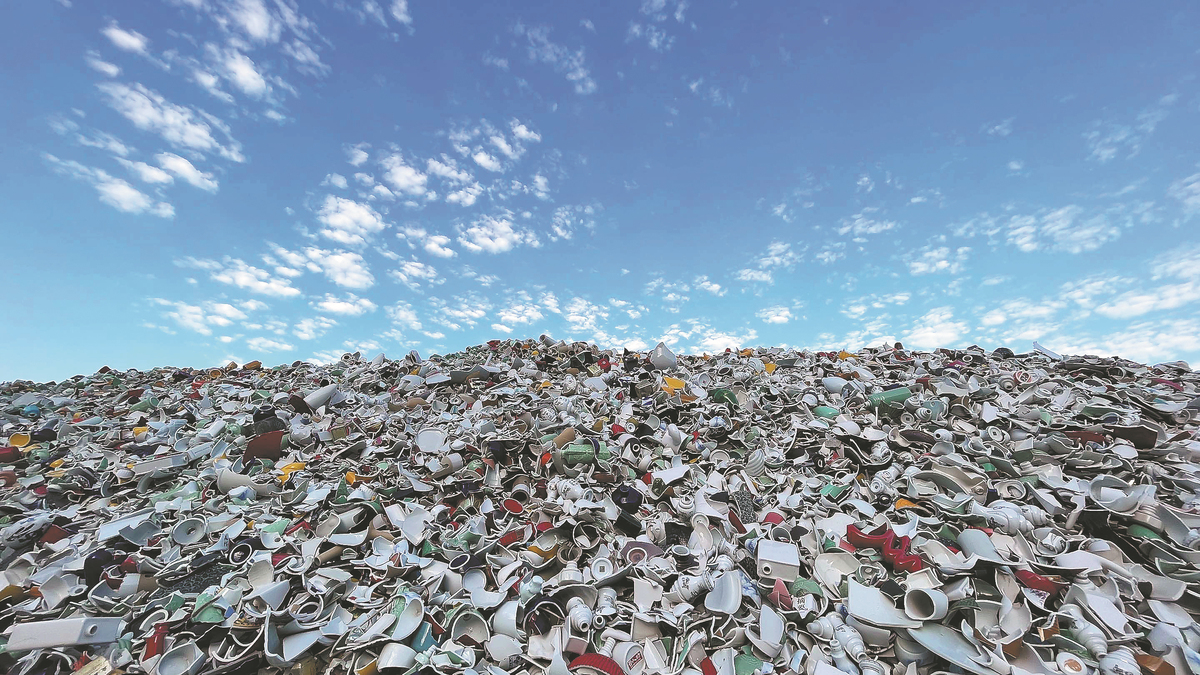
A 'ceramic mountain' of waste collected from several recycling points is seen in Jingdezhen, Jiangxi province. CHINA DAILY
Ceramic 'mountains' cleared
In Chaozhou, Guangdong province, another major ceramic production city in China, steps have been taken in recent years to clean up waste problems.
Due to a wastage rate of 5 to 10 percent during the production process, the accumulation of "ceramic mountains" posed a significant problem for the city's ecology.
Chen Ruihong, deputy director of the city's Ecological Environment Bureau, said that there are over 10,000 ceramic factories in Chaozhou, most of which are small businesses.
"Ceramic waste was often dumped anywhere in the city. Waste disposal was done haphazardly, and nobody cared where it went," he said.
In 2017, Chaozhou officials established a waste disposal site and introduced special operations to address the problem. They also encouraged larger firms to upgrade their equipment and technology, and use market mechanisms to achieve breakthroughs in comprehensive recycling.
Within 12 months of taking action, Chaozhou had processed 67,000 tons of ceramic waste.
In 2018, the Ministry of Ecology and Environment released a nationwide regulation to establish a system of standards to control pollution emissions. In 2020, another document was issued that specified the basic principles, content, calculation methods, and requirements to strongly account for pollutant sources, including the manufacturing of ceramic products.
At the same time, large domestic ceramic production enterprises also stepped up their efforts to recycle ceramic waste. Chaozhou's ceramic waste recycling and disposal capacity now meets the needs of the entire city, officials said.
Oceano, a tile manufacturer with factories in Jingdezhen and Foshan, Guangdong, has been researching ways to recycle and utilize ceramics for a couple of years.
"At present, we have established a green recycling system in our factories, and most of the waste generated during production can be recycled internally for use as new building materials," said Rong Liang, deputy general manager of Oceano in Jingdezhen.
At its Jingdezhen factory, Oceano's annual output of ceramic building materials is about 22 million square meters, with a recycled ceramic reuse volume of about 40,000 tons.
In Foshan, the amount is about 5 million square meters, with a recycled ceramic reuse volume of about 10,000 tons.
To increase the recycling of ceramic waste, Wang, the professor, suggested implementing a "dual-cycle system" for handling waste.
Large ceramic production companies should prioritize internal recycling, where their waste can be treated and reused in production, in order to achieve zero emissions from ceramic waste, Wang said.
"On a larger scale, establishing a circular system for ceramic waste utilization within industrial parks where ceramic production companies are clustered can help consume ceramic waste internally," said the professor.
Local governments should also introduce more regulations, while the ceramics industry can promote green and low-carbon development, Wang said.
Achieving this goal not only saves energy and reduces emissions, but also helps spread the use of environmental protection technologies.
An absorbing idea
Transforming ceramic waste into sustainable building materials is an innovation Yi Design specializes in.
Over the past three years, Yi Design has developed four types of recycled tiles and bricks.
"Our lab focuses on researching ceramic waste and solid waste as primary raw building materials, with an emphasis on art and aesthetics, to develop sustainable and environmentally friendly materials and products for the construction and design sectors," said Deng Peiran, head of the company's design department.
Yin Yi, one of the co-founders of Yi Design, said that building blocks the company has made from ceramic waste can be used as an "absorbent alternative" to conventional cement bricks in various situations.
"The recycled brick's standout features are not only its great water permeability, but also its water storage capacity," said Yin. "When laid in a city, they can absorb condensation water when temperatures are cooler, with each brick capable of holding around 200 milliliters of water. As the sun rises and temperatures increase, the stored water evaporates from the bricks, helping to cool the environment," Yin said.
In addition to their cooling effect, these bricks can be used to collect rainwater in urban areas.
Pavers laid on city streets use cement, which prevents rainwater from seeping into the soil, Yin said.
However, if permeable eco-friendly bricks are used to collect rainwater, the water can be recycled and reused, he said.
"It's perfect for sponge cities — urban spaces that retain stormwater, before gradually filtering and releasing it — or for outdoor use in paved areas and gardens."
Yin's interest in ceramic waste recycling began in 2018 when he decided to do a master's degree on future materials at Central Saint Martins, a university in the United Kingdom.
Upon returning to China during the COVID-19 pandemic, Yin and Cheng established Yi Design. Yin is responsible for product development and laboratory and factory operations, while Cheng handles external promotions and operations.
Over the past three years, Yi Design's products have won multiple international prizes, including the BLT Built Design Awards Winner 2022 and Red Dot Awards 2022 Winner. In 2023, the company also won the Kering Generation Award.
Practical uses
So far, Yi Design has cooperated with about 60 factories and more than 40 ceramic studios to collect ceramic waste. Over 5,000 tons of ceramic waste has been collected.
The company's products have also been used in several projects, including the tiled wall of fashion company COS's store in Shanghai's Century Plaza shopping mall. Their recycled permeable bricks have been used in the outdoor floor area of a coffee-themed community building jointly established by Tongji University and the coffee chain Starbucks in Shanghai.
Yin said their next step is to reduce costs and explore the possibility of increasing mass production of their materials.
"In the future, we hope to achieve large-scale production and help realize the green development and transformation of the ceramic industry," Yin said.
Yan, the 3D-printing products vendor, said that although Yi Design reuses some ceramic waste to make their products, this may not be the sole solution to the ceramic waste problem. "But they have presented this problem to the public, making people aware of its existence, while also providing a solution," he said.
"People lack imagination when it comes to environmental problems such as the existence of ceramic waste piles the size of mountains outside factories, which few people know about," Yan added.
"But Yi Design's philosophy is changing my thoughts and behavior, as well as those of many other people, making us more respectful of and protective of the environment. I believe that more and more people will make their own changes for the environment in the future."
Photos
Related Stories
- Trending in China | Eternal white moonlight: Moon white
- Exploring beauty of Dehua porcelain in SE China's Fujian
- Artists from home and abroad chase dreams in Jingdezhen, China's porcelain capital
- Trending in China | Linglong porcelain
- Neil Brownsword: Exploring exchanges between China and the West through ceramics
- Jingdezhen: Nature always wears the colors of the spirit
Copyright © 2024 People's Daily Online. All Rights Reserved.






